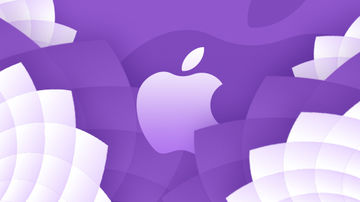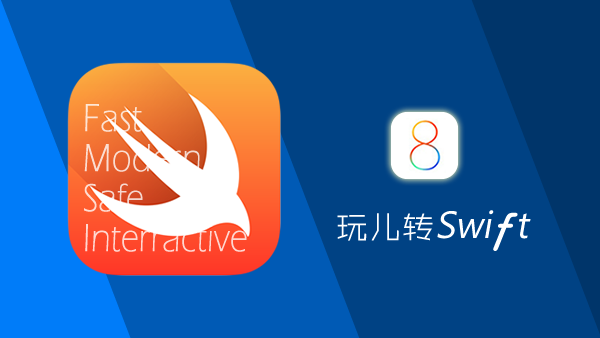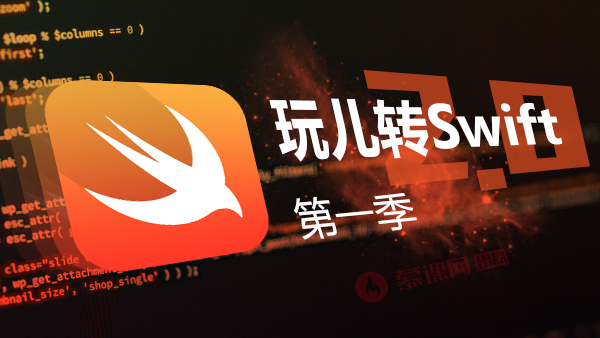概述
做了这么多年的客户端研发一直在使用苹果爸爸推荐的MVC架构模式。MVC从应用层面进行分层开发,极大优化了我们的代码结构,简单易上手,很容易被程序员所接受。程序员刚接手一个新项目,如果是MVC的架构模式,会减少代码熟悉时间,快速的进行开发和维护工作,实际上对于多人开发维护的项目,MVC仍然是非常好的架构模式,这也是这种架构模式经久不衰的原因。
但是任何事物都有两面性,随着项目需求的增加,业务逻辑、网络请求、代理方法等都往Controller层加塞,导致Controller层变得越来越臃肿,动辄上千行的代码量绝对是维护人员的噩梦,因此在MVC基础上逐渐衍生出来了MVP、MVVM等架构模式。
本文是基于OC代码进行阐述的,使用iOS开发经典的 TableView 列表来分析每个架构模式。相信看了这篇文章你会有所领悟。当然一千个人眼中有一千种哈姆雷特,具体在业务开发中使用哪种模式需要你自己去衡量。
1.传统的MVC设计模式

M: Model 数据层,负责网络数据的处理,数据持久化存储和读取等工作V: View 视图层,负责呈现从数据层传递的数据渲染工作,以及与用户的交互工作C: Controller控制器,负责连接Model层跟View层,响应View的事件和作为View的代理,以及界面跳转和生命周期的处理等任务
用户的交互逻辑
用户点击 View(视图) --> 视图响应事件 -->通过代理传递事件到Controller–>发起网络请求更新Model—>Model处理完数据–>代理或通知给Controller–>改变视图样式–>完成
可以看到Controller强引用View与Model,而View与Model是分离的,所以就可以保证Model和View的可测试性和复用性,但是Controller不行,因为Controller是Model和View的中介,所以不能复用,或者说很难复用。
iOS开发实际使用的MVC架构
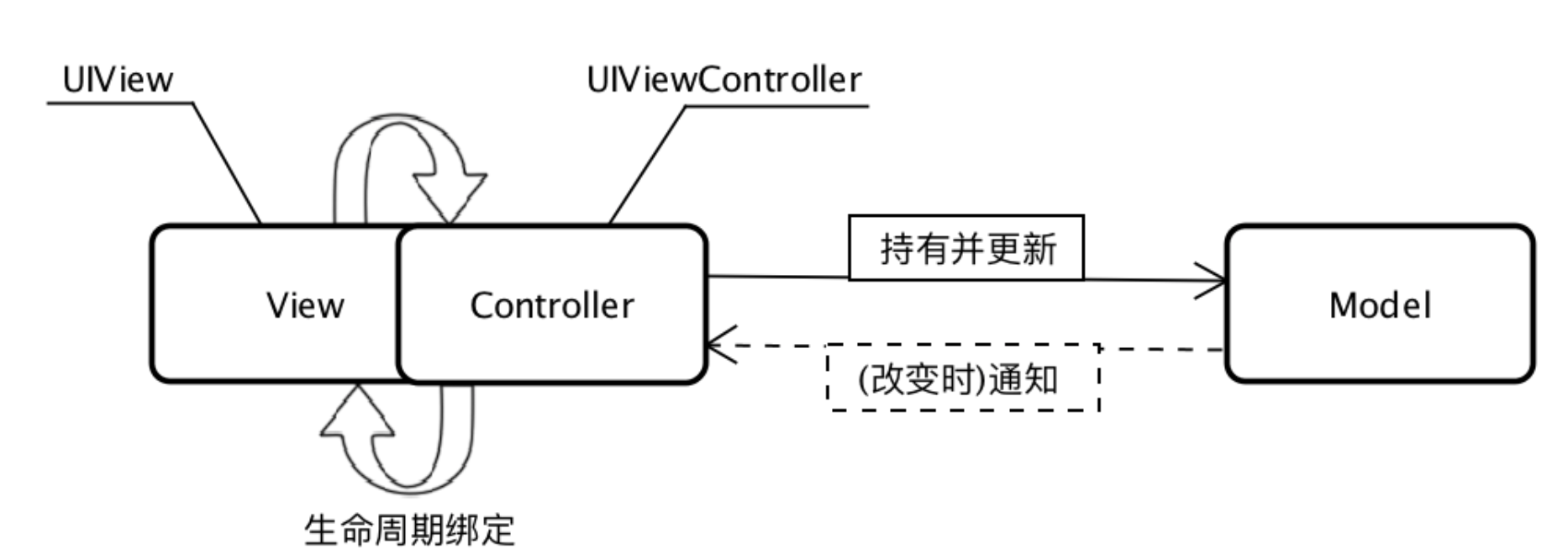 在我们实际开发中使用的MVC模式可以看到,View与Controller耦合在一起了。这是由于每一个界面的创建都需要一个Controller,而每一个Controller里面必然会带一个View,这就导致了C和V的耦合。这种结构确实可以提高开发效率,但是一旦界面复杂就会造成Controller变得非常臃肿和难以维护。
在我们实际开发中使用的MVC模式可以看到,View与Controller耦合在一起了。这是由于每一个界面的创建都需要一个Controller,而每一个Controller里面必然会带一个View,这就导致了C和V的耦合。这种结构确实可以提高开发效率,但是一旦界面复杂就会造成Controller变得非常臃肿和难以维护。
MVC代码示例
我们要实现一个简单的列表页面,每行cell都一个按钮,点击按钮前面数字➕1操作。 核心代码:
核心代码:
// Controller
- (UITableViewCell*)tableView:(UITableView *)tableView cellForRowAtIndexPath:(NSIndexPath *)indexPath{
__weak typeof(self) wealSelf = self;
MVCTableViewCell *cell = [tableView dequeueReusableCellWithIdentifier:@"Cell_identifer"];
if(cell == nil){
cell = [[MVCTableViewCell alloc] initWithStyle:UITableViewCellStyleDefault reuseIdentifier:@"Cell_identifer"];
}
DemoModel *model = self.dataArray[indexPath.row];
[cell loadDataWithModel:model];
cell.clickBtn = ^{
NSLog(@"id===%ld",model.num);
[wealSelf changeNumWithModel:model];
};
cell.selectionStyle = UITableViewCellSelectionStyleNone;
return cell;
}
/*
* 用户点击事件通过Block传递过来后,在Controller层处理更新Mdoel以及更新视图的逻辑
*/
- (void)changeNumWithModel:(DemoModel*)model{
model.num++;
NSIndexPath *path = [NSIndexPath indexPathForRow:model.Id inSection:0];
[self.mainTabelView reloadRowsAtIndexPaths:@[path] withRowAnimation:UITableViewRowAnimationLeft];
}
复制代码
- 可以看到用户点击事件通过Block传递过来后,在Controller层处理更新Mdoel以及更新视图的逻辑
2.MVP设计模式
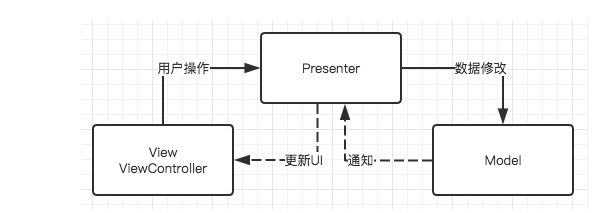
M: Model 数据层,负责网络数据的处理,数据持久化存储和读取等工作V: View 视图层,负责呈现从数据层传递的数据渲染工作,以及与用户的交互,这里把Controller层也合并到视图层P: Presenter层,负责视图需要数据的获取,获取到数据后刷新视图。响应View的事件和作为View的代理。
可以看到 MVP模式跟原始的MVC模式非常相似,完全实现了View与Model层的分离,而且把业务逻辑放在了Presenter层中,视图需要的所有数据都从Presenter获取,而View与 Presenter通过协议进行事件的传递。
用户的交互逻辑
用户点击 View(视图) --> 视图响应事件 -->通过代理传递事件到Presenter–>发起网络请求更新Model–>Model处理完数据–>代理或通知给视图(View或是Controller)–>改变视图样式–>完成
MVP代码示例

//DemoProtocal
import <Foundation/Foundation.h>
@protocol DemoProtocal <NSObject>
@optional
//用户点击按钮 触发事件: UI改变传值到model数据改变 UI --- > Model 点击cell 按钮
-(void)didClickCellAddBtnWithIndexPathRow:(NSInteger)index;
//model数据改变传值到UI界面刷新 Model --- > UI
-(void)reloadUI;
@end
复制代码
- 我们把所有的代理抽象出来,成为一个Protocal文件。这两个方法的作用:
-(void)didClickCellAddBtnWithIndexPathRow:(NSInteger)index;:Cell视图调用它去Presenter层实现点击逻辑的处理-(void)reloadUI;: Presenter调用它去更新主视图View或者Controller
//Presenter.h
#import <Foundation/Foundation.h>
#import <UIKit/UIKit.h>
#import "DemoProtocal.h"
NS_ASSUME_NONNULL_BEGIN
@interface Presenter : NSObject
@property (nonatomic, strong,readonly) NSMutableArray *dataArray;
@property (nonatomic, weak) id<DemoProtocal>delegate;//协议,去更新主视图UI
// 更新 TableView UI 根据需求
- (void)requestDataAndUpdateUI;
//更新 cell UI
- (void)updateCell:(UITableViewCell*)cell withIndex:(NSInteger)index;
@end
复制代码
dataArray: 视图需要的数据源- (void)requestDataAndUpdateUI;:主视图Controller调用,去更新自己的UI- (void)updateCell:(UITableViewCell*)cell withIndex:(NSInteger)index;:更新 Cell的UI
//Controller 层
- (void)iniData{
self.presenter = [[Presenter alloc] init];
self.presenter.delegate = self;
[self.presenter requestDataAndUpdateUI];
}
...
- (NSInteger)tableView:(UITableView *)tableView numberOfRowsInSection:(NSInteger)section{
return self.presenter.dataArray.count;
}
- (UITableViewCell*)tableView:(UITableView *)tableView cellForRowAtIndexPath:(NSIndexPath *)indexPath{
MVPTableViewCell *cell = [tableView dequeueReusableCellWithIdentifier:@"Cell_identifer"];
if(cell == nil){
cell = [[MVPTableViewCell alloc] initWithStyle:UITableViewCellStyleDefault reuseIdentifier:@"Cell_identifer"];
}
//更新cell UI 数据
[self.presenter updateCell:cell withIndex:indexPath.row];
cell.selectionStyle = UITableViewCellSelectionStyleNone;
return cell;
}
#pragma mark - DemoProtocal
//Presenter 的代理回调 数据更新了通知View去更新视图
- (void)reloadUI{
[self.mainTabelView reloadData];
}
复制代码
- Controller层初始化Presenter,调用其方法更新自己的UI,可以看到网络数据的获取,处理都在Presenter中,处理完成后通过协议回调给Controller去reload数据
//Cell
- (void)addBtnDown:(UIButton*)btn{
NSLog(@"%s",__func__);
if([self.delegate respondsToSelector:@selector(didClickCellAddBtnWithIndexPathRow:)]){
[self.delegate didClickCellAddBtnWithIndexPathRow:self.index];
}
}
复制代码
- Cell层点击事件通过协议调用,而这个协议方法的实现是在Presenter中实现的。
MVP模式也有自身的缺点,所有的用户操作和更新UI的回调需要定义,随着交互越来越复杂,这些定义都要有很大一坨代码。逻辑过于复杂的情况下,Present本身也会变得臃肿。所以衍生出了MVVM模式。
3.MVVM+RAC设计模式

M: Model 数据层,负责网络数据的处理,数据持久化存储和读取等工作V: View 视图层,此时的视图层包括Controller,负责呈现从数据层传递的数据渲染工作,以及与用户的交互VM:ViewModel层,负责视图需要数据的获取,获取到数据后刷新视图。响应View的事件和作为View的代理等工作。
通过架构图可以看到,MVVM模式跟MVP模式基本类似。主要区别是在MVP基础上加入了双向绑定机制。当被绑定对象某个值的变化时,绑定对象会自动感知,无需被绑定对象主动通知绑定对象。可以使用KVO和RAC实现。我们这里采用了RAC的实现方式。关于RAC如果不熟悉的小伙伴可以点这里,我们这篇文章不在涉及。
MVVM代码示例

我们这里包括两层视图:主视图Controller以及Cell,分别对应两层ViewModel:ViewModel和CellViewModel
//ViewModel.h
@interface ViewModel : NSObject
//发送数据请求的Rac,可以去订阅获取 请求结果
@property (nonatomic,strong,readonly) RACCommand *requestCommand;
@property (nonatomic,strong) NSArray *dataArr;//返回子级对象的ViewModel
- (CellViewModel *)itemViewModelForIndex:(NSInteger)index;
@end
复制代码
RACCommand *requestCommand:提供供主视图调用的命令,调用它去获取网络数据NSArray *dataArr: 提供供主视图使用的数据源,注意这里不能用NSMutableArray,因为NSMutableArray不支持KVO,不能被RACObserve。- (CellViewModel *)itemViewModelForIndex:(NSInteger)index;根据Cell的index返回它需要的的ViewModel
@interface CellViewModel : NSObject
@property (nonatomic,copy,readonly) NSString *titleStr;
@property (nonatomic,copy,readonly) NSString *numStr;
@property (nonatomic,copy,readonly) RACCommand *addCommand;
- (instancetype)initWithModel:(DemoModel *)model;
@end
复制代码
CellViewModel: 暴露出Cell渲染需要的所有数据RACCommand *addCommand;: 按钮点击事件的指令,触发后需要在CellViewModel里面做处理。
//controller
- (void)iniData{
self.viewModel = [[ViewModel alloc] init];
// 发送请求
RACSignal *signal = [self.viewModel.requestCommand execute:@{@"page":@"1"}];
[signal subscribeNext:^(id x) {
NSLog(@"x=======%@",x);
if([x boolValue] == 1){//请求成功
[self.mainTabelView reloadData];
}
}];
}
- (UITableViewCell*)tableView:(UITableView *)tableView cellForRowAtIndexPath:(NSIndexPath *)indexPath{
MVVMTableVIewCell *cell = [tableView dequeueReusableCellWithIdentifier:@"Cell_identifer"];
if(cell == nil){
cell = [[MVVMTableVIewCell alloc] initWithStyle:UITableViewCellStyleDefault reuseIdentifier:@"Cell_identifer"];
}
//更新cell UI 数据
cell.cellViewModel = [self.viewModel itemViewModelForIndex:indexPath.row];
cell.selectionStyle = UITableViewCellSelectionStyleNone;
return cell;
}
复制代码
iniData:初始化ViewModel,并发送请求命令。这里可以监听这个完成信号,进行刷新视图操作cell.cellViewModel = [self.viewModel itemViewModelForIndex:indexPath.row];根据主视图的ViewModel去获取Cell的ViewModel,实现cell的数据绑定。
//TableViewCell
RAC(self.titleLabel,text) = RACObserve(self, cellViewModel.titleStr);
RAC(self.numLabel,text) = RACObserve(self, cellViewModel.numStr);
[[self.addBtn rac_signalForControlEvents:UIControlEventTouchUpInside] subscribeNext:^(id x) {
NSLog(@">>>>>");
[self.cellViewModel.addCommand execute:nil];
}];
复制代码
- 在Cell里面进行与ViewModel的数据绑定,这边有个注意Racobserve左边只有self右边才有viewModel.titleStr这样就避Cell重用的问题。
[self.cellViewModel.addCommand execute:nil];:按钮的点击方法触发,事件的处理在CellViewModel中。
总结
- 经过几十年的发展和演变MVC模式出现了各种各样的变种,并在不同的平台上有着自己的实现。在实际项目开发中,根据具体的业务需求找到适合的架构才是最好的,架构本身并没有好坏之分。
- 最后对文中的MVC、MVP、MVVM架构的描述也掺杂了作者的主观意见,如果对文中的内容有疑问,欢迎提出不同的意见进行讨论。
作者:QiShare
链接:https://juejin.cn/post/6964252878726758407
著作权归作者所有。商业转载请联系作者获得授权,非商业转载请注明出处。

 随时随地看视频
随时随地看视频

